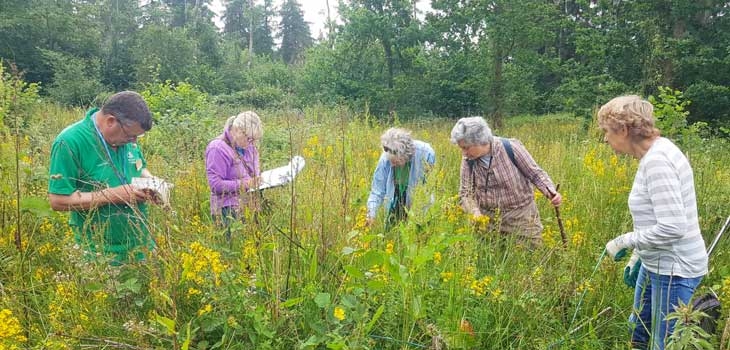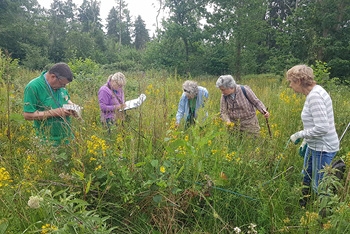Silk Wood Community Planting Project: Baseline monitoring
The Silk Wood Community Planting Project aims to regenerate 5 hectares of clear-felled ash within Silk Wood, as a result of an ash dieback outbreak. As the name suggests, the project has a focus on community engagement, and as such the woodland will be designed, planted, managed, and monitored by community groups, schools and other volunteers. Monitoring will include recording the survival rates of different tree species, and seeing what flora and fauna are present on site. This was kicked off with a baseline floral survey which will provide a reference point that future surveys can be compared to. The site has been left bare for a few years to allow the soils to recover from the harvesting machinery and has since become almost completely covered by a dense sward of herbs, ferns, grasses, rushes and sedges. Westonbirt’s flora volunteers rose to the task of performing this survey.
This survey covered 2.6 hectares of the project area, the block adjacent to the 2000-year-old lime, as this will be the first area to be planted. Five evenly distributed 4m2 plots were chosen to gain a fair representation. In each plot, every species was recorded and assigned an estimate of percentage cover. These results were then compared with descriptions given in British Plant Communities Volume 1 (Rodwell et al., 1991) to find the vegetation community type.

The survey was conducted on 16/06/2023, a hot and sunny day. Accessing the site proved to be quite a challenge due to the dense vegetation, with bramble thickets being the greatest obstacle.
During the survey, a total of 84 species were recorded: 2 ferns, 15 grasses/sedges/rushes, 11 woody plants and 56 herbs. No rarities were found, but based on the species present, the National Vegetation Classification (NVC) community is likely W8 Fraxinus excelsior - Acer campestre - Mercurialis perennis woodland, (AKA lowland ash woodland). This is in line with the presence of ash saplings and dog's Mercury, along with other associated species like wood anemone, common knapweed and bluebell.
As the project progresses, areas will be cleared of vegetation in readiness for tree planting. It will be interesting to compare future surveys to see how the site changes over time with the addition of new trees. Knowing the NVC type also gives an insight into what trees will grow well in this area – in W8 woodland, lime, hornbeam and pedunculate oak are common, all of which we are hoping to include in the new planting.
We will not be planting any ash, however, as ash dieback is still likely to be prevalent for many years to come. It is estimated that we will lose 80% of ash trees in the UK. Tolerance is found in around 1-5% of ash, and there are currently many trials being undertaken to attempt to breed from tolerant trees. Ash isn’t the only species currently at risk in the UK - oaks are under pressure from acute oak decline, the great spruce bark beetle is now established and threatens our spruce plantations and Phytopthora ramorum has caused hundreds of thousands of larch to be felled. Practising good biosecurity when visiting woodlands is important to prevent disease spread, this includes cleaning your footwear before and after visits and washing car or bike wheels.
I would like to extend a big thank you to the flora volunteers at Westonbirt who braved the sun and the brambles to get this first survey complete.
Find out more about how Oscar has been preparing for this project in our other blogs...
You can support the work of the National Arboretum by making a donation today so that Westonbirt continues to be a safe, accessible, green space for everyone for generations to come.
